专项复习:名词
复习专项—名词
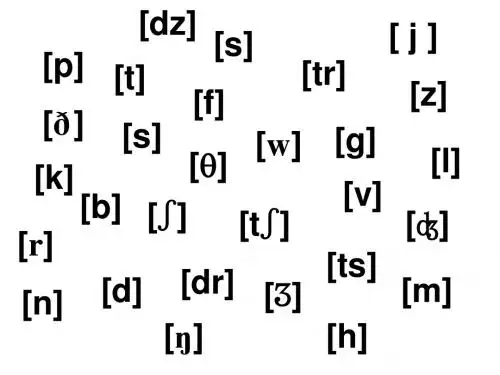
babies countries factories boys monkeys
规则五:以元音字母 结尾 直接加s 结尾, 规则五:以元音字母+y结尾,直接加
不规则的名词复数
man woman tooth foot child men women teeth feet children
单复数同形 sheep deer fish Chinese Japanese sheep deer fish Chinese Japanese
规则4: 结尾变f, 为 规则 :以f,fe结尾变 fe为ves 结尾变
leaf
leaves
knife
knives
wife
wives
wolf
wolves
规则五:以辅音字母 结尾 结尾, 规则五:以辅音字母+y结尾,变y为i加es 为加
baby country factory boy monkey
boxes
watches buses dishes classes
结尾, 则3:以o结尾,除以下三个词外都加 : 结尾 除以下三个词外都加s.
tomato potato hero
tomatoes potatoes heroes
口诀: 口诀:英雄喜欢吃西红柿和土豆
radio zoo photo
radiæ] [ɒi] ɒ [i] [ei]
[eə] [uə] [əu] [ai] [ʌ]
名词是表示人,事物 事物,地点等 名词 :名词是表示人 事物 地点等 名称 举例:学生、 举例:学生、车、房子、北方。。。 房子、北方。。。 可数名词:指能以数目来计算, 可数名词 指能以数目来计算,可以分成 指能以数目来计算 个体的人或东西 不可数名词:不能用数字计算的 不可数名词 不能用数字计算的
中考英语复习专项——名词
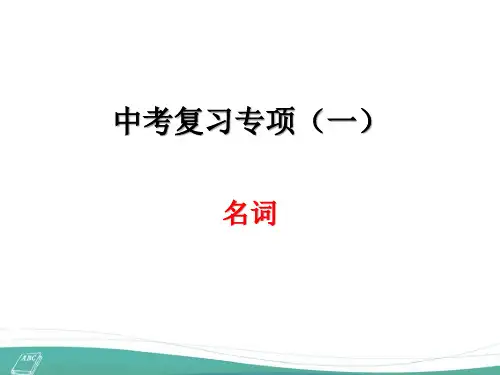
A. minute’s
B. minute
C. minutes’
D. minutes
2. The mascot (吉祥物) of Rio 2016 Olympic
Games is B good luck.
A. the number of
B. the symbol of
C. the day of
D. the color of
A. was
B. is C. were
so useful that
A
D. are
考点二:不可数名词
2. 不可数名词可以由 some,much,little,a lot of,lots of, plenty of 等词修饰。 如:They have saved much money for future use. 他们存了很多钱以备未来使用。
WTO(世贸);China Daily(中国日报)
Sunday;English; January;Spring Festival
由普通名词构成的专有 the Great Wall 名词,一般前面加the
考点自测
1. A is the world’s highest peak.Few people can climb to the top.
D. National Day
3. B Day is coming. I will buy some源自for MissWu.
A. Teacher’s;flower
B. Teachers’;flowers
C. Teachers’;flower
D. Teacher’s;flowers
4.Tu Youyou won China’s first Nobel Prize in Medicine in
英语名词专项复习题带答案
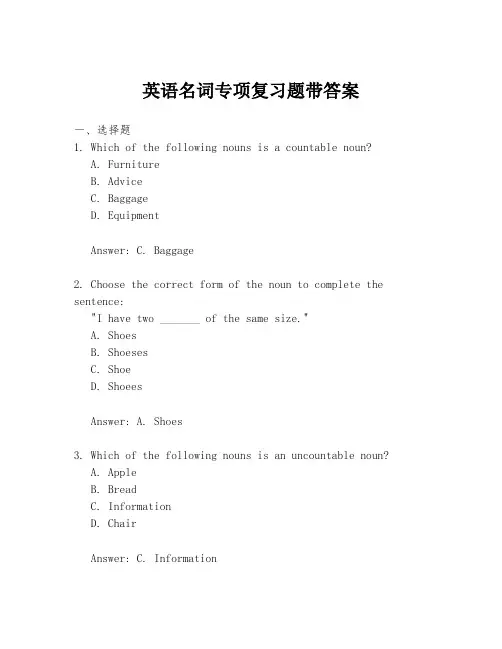
英语名词专项复习题带答案一、选择题1. Which of the following nouns is a countable noun?A. FurnitureB. AdviceC. BaggageD. EquipmentAnswer: C. Baggage2. Choose the correct form of the noun to complete the sentence:"I have two _______ of the same size."A. ShoesB. ShoesesC. ShoeD. ShoeesAnswer: A. Shoes3. Which of the following nouns is an uncountable noun?A. AppleB. BreadC. InformationD. ChairAnswer: C. Information4. Select the noun that is used to describe a group of people working together.A. TeamB. GroupC. CrowdD. AudienceAnswer: A. Team5. The noun "________" refers to a person who has aparticular skill or knowledge.A. ExpertB. AmateurC. NoviceD. ProfessionalAnswer: A. Expert二、填空题6. The ________ of the building is impressive.(Hint: the exterior appearance)Answer: Facade7. She has a wealth of ________ in her field.(Hint: knowledge or understanding)Answer: Knowledge8. The ________ of the company has increased significantly this year.(Hint: total amount of money)Answer: Revenue9. He is a ________ of the local football club.(Hint: person who supports a sports team)Answer: Fan10. The ________ of the old bridge was a sad event for the community.(Hint: destruction or breaking down)Answer: Demolition三、改错题11. There are many informations about the event online.(Correct the sentence)Answer: There is a lot of information about the event online.12. I have three brothers and two sisters, so I have five siblings in total.(Identify the error and correct it)Answer: The sentence is correct.13. The equipments in the gym are very modern.(Correct the sentence)Answer: The equipment in the gym is very modern.14. She gave me a lot of advices about my career.(Correct the sentence)Answer: She gave me a lot of advice about my career.15. The committee consists of five members, including two females and three males.(Identify the error and correct it)Answer: The sentence is correct.四、简答题16. What is the difference between a countable noun and an uncountable noun?Answer: A countable noun is a noun that can be counted and has both singular and plural forms. An uncountable noun, on the other hand, is a noun that cannot be counted and does not have a plural form. It is used to refer to things that are considered as a whole or are not easily divisible into separate units.17. Can you give an example of a collective noun?Answer: A collective noun is a noun that represents a group of people, animals, or things taken as a whole. For example, "team" is a collective noun that can refer to a group of players working together.18. What is the correct way to use the noun "data"?Answer: "Data" is an uncountable noun and is used torefer to facts or figures provided or available for analysis. It does not have a plural form, so it should not be used as "datas."19. Explain the difference between "few" and "a few".Answer: "Few" and "a few" are quantifiers used with countable nouns. "Few" implies a small number, often with a negative connotation, suggesting that the number is less than expected. "A few" means a small number, but it has a more positive connotation, suggesting that there is a small but satisfactory amount.20. What is the singular form of the noun "geese"?Answer: The singular form of "geese" is "goose."结束语:通过这些复习题,我们希望能够帮助学生巩固对英语名词的理解,包括可数名词和不可数名词的区别、名词的单复数形式、以及名词在句子中的恰当使用。
初中语法专项复习
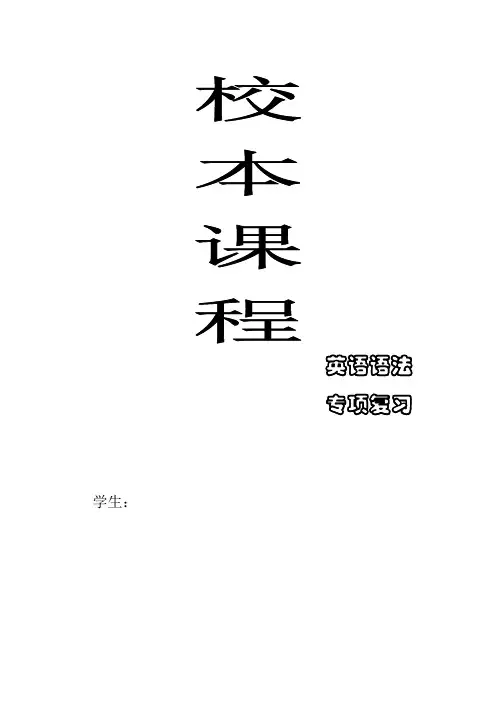
英语语法专项复习学生:目录1 名词 (3)2 冠词 (5)3 代词 (7)4 介词 (10)5 连词 (12)6 数词 (15)7 形容词 (17)8 副词 (19)9 动词的时态 (22)10 动词的语态 (25)11 情态动词 (26)12非谓语动词 (28)13 简单句 (33)14 并列句 (35)15 复合句 (36)16 主谓一致 (39)17 倒装句部分 (42)语法专项复习语法复习专项复习(一):名词一、名词的分类名词的分类:名词按其意义可分为专有名词和普通名词,其中普通名词按其可数性又可分为可数名词和不可数名词。
A.可数名词可数名词一般有单数和复数两种形式。
1、可数名词复数形式的规则变化(1)绝大部分可数名词在单数名词词尾加s。
如:dog → dogs, map →maps(2) 以s, x, ch , sh 结尾的名词加es。
如:class →classes, box →boxes, church →churches, dish →dishes注意:stomach的复数形式为stomachs。
(3)以“辅音字母+y”结尾的名词,变y为i,加-es。
如:city →cities, country →countries 以“元音字母+y”结尾的名词,直接加-s。
如:boy →boys, toy →toys(4) 以o 结尾的名词多数直接加-es。
如:hero →heroes,tomato →tomatoes, patato →potatoes但以“元音字母+o”结尾的名词,直接加-s,如:zoo →zoos, radio →r adios注意:photo的复数为photos。
(5)以f或fe结尾的名词,变f,fe为v,再加-es。
如:shelf →shelves,knife →knives 但也有特殊情况。
如:roof →roofs,chief →chiefs2、可数名词复数形式的的不规则变化(1)变内部元音字母的名词。
中考英语专项复习-名词所有格(答案)
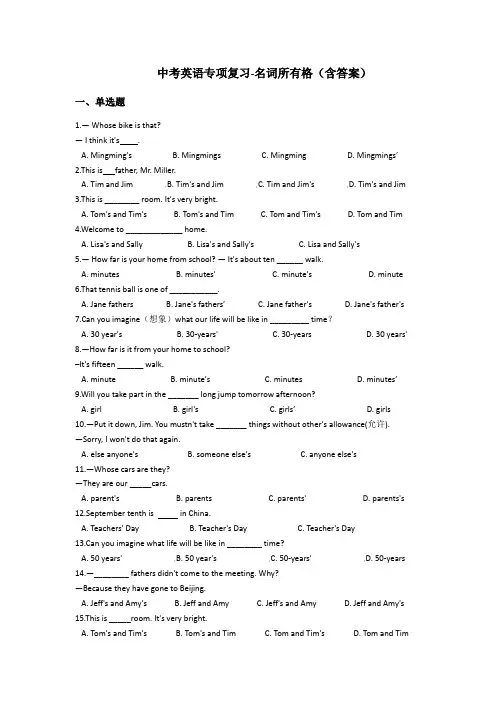
中考英语专项复习-名词所有格(含答案)一、单选题1.— Whose bike is that?— I think it's.A.Mingming'sB.MingmingsC.MingmingD.Mingmings’2.This is father, Mr. Miller.A.Tim and JimB.Tim's and JimC.Tim and Jim'sD.Tim's and Jim3.This is ________ room. It's very bright.A.Tom's and Tim'sB.Tom's and TimC.Tom and Tim'sD.Tom and Tim4.Welcome to _____________ home.A.Lisa's and SallyB.Lisa's and Sally'sC.Lisa and Sally's5.— How far is your home from school? — It's about ten ______ walk.A.minutesB.minutes'C.minute'sD.minute6.That tennis ball is one of ___________.A.Jane fathersB.Jane's fathers’C.Jane father'sD.Jane's father's7.Can you imagine(想象)what our life will be like in _________ time?A.30 year'sB.30-years'C.30-yearsD.30 years'8.—How far is it from your home to school?─It's fifteen ______ walk.A.minuteB.minute'sC.minutesD.minutes’9.Will you take part in the _______ long jump tomorrow afternoon?A.girlB.girl'sC.girls’D.girls10.—Put it down, Jim. You mustn't take _______ things without other's allowance(允许).—Sorry, I won't do that again.A.else anyone'sB.someone else'sC.anyone else's11.—Whose cars are they?—They are our _____cars.A.parent'sB.parentsC.parents'D.parents's12.September tenth is in China.A.Teachers' DayB.Teacher's DayC.Teacher's Day13.Can you imagine what life will be like in ________ time?A.50 years'B.50 year'sC.50-years'D.50-years14.—________ fathers didn't come to the meeting. Why?—Because they have gone to Beijing.A.Jeff's and Amy'sB.Jeff and AmyC.Jeff's and AmyD.Jeff and Amy's15.This is _____room. It's very bright.A.Tom's and Tim'sB.Tom's and TimC.Tom and Tim'sD.Tom and Tim16.Which is the ________ biggest city?A.IndianB.IndiansC.Indian'sD.Indians'17._____ mothers can't go to the parents' meeting because they are too busy.A.Jack's and PaulB.Jack and PaulC.Jack and Paul'sD.Jack's and Paul's18.We will have a _________ holiday after the exam.A.two monthB.two months'C.two-month.D.two-months19.Mr. Brown is _____ father.A.Lucy and LilyB.Lucy's and Lily'sC.Lucy and Lily's20.—Is the room only for Amy?—No, it's _________.A.Amy's and her sister'sB.Amy's and her sisterC.Amy and her sisterD.Amy and her sister's21.The girl is Mr Green's ____ daughter.A.friendB.Friend'sC.a friend22.Teenagers should have at least ________ sleep in the evening.A.eight hour'sB.eight hours'C.eight hour'sD.eight hours'23.—What's your __________ jobs?—They are doctors.A.parent'sB.parents’C.parentsD.parents's24.—Whose hot dog is this, Hobo?—It's.A.herB.Eddies'C.Eddie's25.In the dark, he hurried to put on _________ coat.A.else someone'sB.someone's elseC.someone else'sD.someone else26.She is ill. She wants to ask for_____.A.two week leaveB.two weeks leaveC.two week's leaveD.two weeks' leave27.This is my room and that is my room.A.parentsB.parent'C.parents'D.parents's28.I was very scared when I found that the brake didn't work on my way ______ the park.A.on; intoB.to; forC.on; onD.on; to29.mothers can't go to the parents' meeting because they are too busy.A.Jack's and PaulB.Jack's and Paul'sC.jack and Paul's30.The train station is about ______ bike ride from the post office.A.twenty minutesB.twenty minute'sC.twenty-minutesD.twenty-minute31.Please come to the ________ Sports Center.A.StudentsB.Students’C.Students's32.— When is ____________?— It's on September 10th.A.Teachers' DayB.Teacher's DayC.Teachers's Day33.I feel a bit tired for I saw a two film last night.A.hourB.hoursC.hour'sD.hours'34.________mothers can't go to the meeting, because they have gone to New York on business.A.Alice and Lily'sB.Alice's and Lily'sC.Alice's and Lily35.The children got to the Forest Park after ____ ride.A.an hour'sB.an hours'C.a hour'sD.one hours'36.— How far is your home from school?— It's about two walk.A.hoursB.hours'C.hour's37.We visited some of the _______ scenic spots.A.citysB.city'sC.cityD.citys'38.—Is this your bedroom, Bill? —No, it isn't. It's_________A.Mike's and Frank'sB.Frank's and MikeC.Mike's and FrankD.Frank and Mike's二、语法填空39.________ (teacher) Day is on September 10th.40.Thanks for all the________(member) hard work! More and more people have learned how to keep kids from danger now.41.Mr. Li gave us 10 ________ (minute) time to finish the hard maths problem.42.It is ________ (my teacher) sweater.43.I think that copying ________(other)homework is wrong.答案一、单选题1.【答案】A【解析】【分析】句意是:—那是谁的自行车?—我想是明明的。
名词冠词

初高中衔接英语语法专项复习:名词 & 冠词名词Noun(n.):表示人或事物的名称。
如:boy / pencil / book冠词Article(art.):用在名称前帮助说明名词所指的人或事物。
如:a(an) / the形容词Adjective(adj.):用以修饰名词、表示人或事物特征。
如:old / red / fine副词Adverb(adv.):用以修饰动词、形容词或其他副词。
如:not / too / here / often代词Pronoun(pron.):用来代替名词、形容词或数词。
如:we / that / his / what介词Preposition(prep):表示名词、代词等和句中其他词的关系。
如:in / on / of / to / under数词Numeral(num.):表示数量或顺序。
如:one / thirteen / first连词Conjunction(conj.):用来连接词与词、短语与短语或句与句。
如:and / or / but感叹词Interjection(interj.):表示说话时的喜悦、惊讶等情感。
如:oh /hello / hi动词Verb(v.):表示动作或状态。
如:look / go / be (am / is / are )名词Noun(n.)名词表示人或事物的名称.◆一名词的分类1. 专有名词:John / China2.普通名词:①可数名词:个体名词:book / table / horse集体名词:family / class / police②不可数名词:物质名词:water / rice / snow抽象名词:health / knowledge / love◇专有名词: 表示具体的人、物、地点、节日等,通常由一个名词或一个词组构成:Jenny / Hong Kong / Christmas Day首字母要大写,但专有名词中的虚词(冠词、介词)的第一个字母不用大写:the Great Wall◆二可数名词(可以用数来计量)的复数⒈规则变化(1) 一般直接加-s . 如:boy → boys cup → cups(2) 以-s,-x,-ch,-sh,结尾加-es,如:wa tch → watches box → boxes注意:但是stomach(胃)的复数是stomachs;ox(公牛)的复数是oxen(3) 以“辅音字母+y ”结尾变y为i再加-es .如:story → stories baby → babies(4) 以f\fe结尾变f\fe为ves .如:①leaf → leaves;②self→ selves; ③wife → wives; ④knife → knives;⑤shelf→ shelves ⑥wolf→ wolves ⑦thief →thieves;⑧life →lives ⑨half → halves;①gulf→ gulfs ②roof→ roofs ③chief →chiefs ④serf→ serfs⑤belief→ beliefs ⑥proof →proofs ⑦handkerchief →handkerchiefs⑤以o 结尾:A.多加-es 如:Negro →Negroes hero → heroes; t omato—tomatoes potato—potatoes;mango—mangoes;volcano—volcanoes总结:英雄土豆爱番茄,黑人芒果看火山。
名词专项复习资料
名词复习一、名词分类(一)按意义分类:专有名词,普通名词1.专有名词表示具体的人,事物,地点,团体或机构的专有名称(第一个字母要大写)例:China 中国Asia 亚洲Beijing 北京the People’s Republic of China 中华人民共和国专有名词如果是含有普通名词的短语,则必须使用定冠词the。
如:the Great Wall(长城)2.普通名词表示某些人,某类事物,某种物质或抽象概念的名称。
(例如:teacher 老师tea 茶)普通名词又可进一步分为四类1.个体名词(Individual Nouns):表示单个的人和事物。
(car 汽车room 房间fan 风扇photo 照片)2.集体名词(Collective Nouns):表示一群人或一些事物的名称。
( people 人们family 家庭army 军队government政府group 集团)3.物质名词(Material Nouns):表示物质或不具备确定形状和大小的个体的物质。
( fire 火steel 钢air 空气water 水milk牛奶)4.抽象名词(Abstract Nouns):表示动作,状态,品质或其他抽象概念。
( labour 劳动health 健康life 生活friendship友情patience耐力) (二)、按是否可数分类名词又可分为可数名词(Countable Nouns)和不可数名词(Uncountable Nouns)不可数名词不可数名词是指不能以数目来计算,它一般没有复数形式,只有单数形式,它的前面不能用不定冠词a / an。
抽象名词,物质名词和专有名词一般是不可数名词可数名词可数名词是指能以数目来计算,可以分成个体的人或东西;因此它有复数形式二、名词的功能名词在句中作主语,宾语,介词宾语,宾语补足语,表语以及名词短语作状语。
1.主语:The bagis in the desk. 书包在桌子里边。
高考英语总复习专项专题名词
(10)以is结尾的外来词变is为es。如: emphasis——emphases强调,重点 crisis——crises危机 basis——bases基础 thesis——theses论题,论文
(二)不可数名词
1.不可数名词一般不分单复数,也不能与 不定冠词a,an直接连用,若要表示数量, 需加适当的单位名词。
zoo——zoos photo——photos
piano——pianos radio——radios
kilo——kilos video——videos
studio——studios bamboo——bamboos
有些以o结尾的名词既可以加s,也可以加es, 如:
zero——zeros/zeroes mottos/mottoes
(2)以s,x,ch,sh结尾的名词在名词后加 es,如:
bus——buses box——boxes
watch——watches brush——brushes
词尾es一般读[Ιz]。但以ch结尾的名词,若 ch发[k]音,则复数应加s,s一般读[s], 如:
stomach——stomachs。
(3)以辅音字母加y结尾的名词将y变成i再加 es,es一般读[z],如:
knife——knives; half——halves; leaf——leaves;
loaf——loaves; wolf——wolves; wife——wives
有些以f或fe结尾的名词只加s,s一般读[s], 如:
roof——roofs屋顶 gulf——gulfs海湾 chief——chiefs首领 belief——beliefs信仰 proof——proofs证据 serf——serfs奴隶 cliff——cliffs悬崖 brief——br (一)可数名词 可数名词一般有单数和复数两种形式,有些
名词1
你说我写 两块面包 two pieces of bread
③词尾加-s. German-Germans, Russian-Russians, Australian-Australians, American-Americans, Roman-Romans, Indian-Indians V. 复合名词的复数形式。 把复合词中的中心词变复数。a son-in-law——sons-in-law 女婿 当第一部分为man或woman时,两部分都变成复数。 A man teacher- two men teachers, a woman doctor-three women doctors
不可数名词
物质名词
指无法分为个体的物质、 材料、食品、饮料、液体、 气体、金属等的名词。
不可数名词 抽象名词
指人或事物的品质、情感、状 态、动作等抽象概念及学科、 疾病等名词的词。
(1)不可数名词的用法。
不可数名词前不能加不定冠词a / an,也没有复数形式,但是 可以用much, some, any等修饰。 中考中常见的不可数名词。 rice大米 news新闻 bread面包 milk 牛奶 beef 牛肉 food 食物 orange 橙汁 work 工作 fun乐趣 advice 建议 music 音乐 trouble麻烦 time时间 weather 天气 information信息 homework 家庭作业 (2)不可数名词的数量表达。
高考英语总复习之语法专项讲解名词
第一章:名词名词的意义和种类一.名词的意义:表示人, 事物, 或抽象概念的词叫做名词二.名词的种类:1.专有名词: 表示具体的人, 事物, 地点或机构的专有名称, 如: China, Lei Feng, Yan’an2.普通名词: 表示某类人或某类事物的名称, 又可分为四类①.个体名词: 表示单个的人或事物, 如: doctor, house, tree, orange, photo②.集体名词: 表示一群人或事物的总称, 如: class, family, group③.物质名词: 表示无法分出个体的物质, 如: rice, steel, water, coal, cotton④.抽象名词: 表示抽象概念的词, 如: victory, health, progress, friendship名词的数一般地说, 个体名词和集体名词是可数的, 称为可数名词; 物质名词和抽象名词一般是不可数的, 称为不可数名词一.可数名词复数形式的构成:1.规则变化:①.一般直接在名词后加-s, 如: desks, maps, bags, days, houses, faces②.以字母s, sh, ch, x结尾的名词后加-es, 如: buses, brushes, watches, boxes③.以字母f 或fe结尾的名词构成复数形式时, 把f / fe改为v, 再加-es, 如: lives, leaves, shelves, knives, wives, thieves, 但roofs, chiefs, gulfs, beliefs, proofs等例外④.以-o结尾的名词的复数多数加-es, 如: heroes, potatoes, tomatoes, Negroes等, 少数加-s, 如: zoos, radios, studios, photos, pianos, bamboos, tobaccos, videos, kilos等⑤.以辅音字母+ y结尾的名词, 要把y改为i, 再加-es, 如: factories, babies, countries2.不规则变化:①.改变单数名词中的元音字母, 如: men, women, feet, geese②.单复数形式相同, 如: sheep, deer, fish, means(方式,方法), jin(斤), yuan(元)③.其他形式, 如: child – children, ox – oxen, mouse – mice④.表示某国人的名词的复数形式因习惯不同而名异a.单复数形式相同(多以-ese结尾), 如: Chinese, Japanese, Swissb.词尾加-s(多以-an结尾), 如: Russians, Germans, Americans, Koreans, Indians, Italians, Greeksc.将man变成men,将woman变成women, 如: Englishman, Englishwomen, Dutchmen⑤.复合名词的复数形式有以下几种情况:a.将复合名词中的主体名词变为复数形式, 如: lookers-on, sons-in-law, step-sons, passers-by, editors-in-chiefb.如果复合名词中没有主体名词, 则在最后一个词的后面加s(或其他复数形式), 如: grown-ups成年人, go-betweens中间人c.有些复合名词的组成部分都要变成复数形式, 如: men servants, women doctors二.不可数名词一般只有单数形式, 但要注意以下几点:1.物质名词的复数可表示多种类, 多量, 多次等含义, 如: fruits各种水果, teas, steels, snows积雪, waters海水(或河水,湖水,江水)2.有些不可数名词的复数形式表示与这个不可数名词不同的意义, 如: greens青菜, times时代, works著作, spirits情绪, irons镣铐, manners礼貌3.有些物质名词有时也是可数名词:a. A glass (玻璃杯) is made of glass.b. Do you have any evening papers (报纸) ?4.专有名词一般只用单数, 但有时也可用复数, 如: the West Indies西印度群岛, the Jacksons杰克逊一家a. There are four Lius in our class.在我们班有四个姓刘的5.物质名词在表示数量时, 常借助一些量词来表示, 如: a cup of tea, two glasses of milk, three pieces of chalk. 可数名词也可用这种形式来表示数量, 如: three boxes of matches, four baskets of apples三.有此名词既可作不可数名词, 也可作可数名词, 但意义常有不同1.物质名词表示种类或具体事物时, 可成为可数名词, 如: tea茶/ teas各种茶, hair头发/ a hair一根头发, glass玻璃/ a glass玻璃杯, paper纸/ papers试卷,论文,报纸2.抽象名词具体化可使之成为可数名词, 如: difficulty表示“困难”时是不可数, 表示“难事”时是可数, 再如: pleasure表示“乐事”, youth表示“青年”时都是可数3.可数名词用来表示抽象意义或物质意义时, 成为不可数名词, 如: room空间, talk空谈, chicken鸡肉名词的格英语中名词有三个格: 主格(作主语), 宾格(作宾语)和所有格一.名词的所有格: 名词中表示所有关系的形式叫做名词的所有格1.表示有生命的东西(人或物)的名词的所有格一般在名词后加’s, 如: my father’s room①.以-s或-es结尾的复数名词的所有格只在名词后加’, 如: the teachers’ reading room, the masses’ advice②.不以-s结尾的复数名词的所有格要加’s, 如: the people’s needs, women’s rights③.若专有名词以-s结尾, 它的所有格一般只加’, 但也有加’s的, 读作[iz], 如: B urns’s poems或Burns’ poem④.复合名词或短语的所有格的’s加在最后一个词之后, 如: her son-in-law’s photo,the commander-in-chief’s report, the king of Spain’s daughter, somebody else’s car⑤.如果一样东西为两人共有, 则在后面一个名词后加’s;如果不是两者共有, 则在两个名词之后都要加’s, 如: Jane and Helen’s room (Jane和Helen共用的房间), Bill’s and Tom’s rooms(Bill的房间和Tom的房间)⑥.在表示店铺, 某人的家的名词所有格后面, 一般省掉它所修饰的名词, 如: the tailor’s裁缝店, the barber’s理发店, at my uncle’s在叔叔家2.表示无生命的名词一般用of构成词组表示所有关系, 如: the cover of the book, the workshops of the factory. 但, 表示时间, 距离, 重量, 国家, 城市, 地点等无生命的名词也可用’s形式来表示其所有关系, 如: three days’ sick leave, half an hour’s walk, today’s newspaper, a ton’s weight, China’s agriculture, Shanghai’s industry.3.指有生命的名词也可以用of词组表示所有格, 常用于以下情况之下:①.名词较长时, 如: the story of doctor Bethune, the works of Marx, Engels and Lenin②.名词的定语较长, 如: the son of the man who you just talked to, the name of the boy standing there4. of +名词的’s所有格形式或名词性物主代词称为双重所有格. 在表示所属物的名词前有冠词, 数词,不定代词或指示代词(如a, two, some, any, such, no, a few, this, that, these, those等)时, 常用双重所有格表示所属关系, 如: a friend of my father’s =one of my father’s friends, two brothers of his, some inventions of Edison’s, these poems of Li Bai’s, a few classmates of Xiao Ming’s, a ny friend of Tom’s, some houses of my grandfa ther’s.关于双重所有格还需注意以下几点:①.在双重所有格中, of前面的名词不和the连用, 如不能说: the new dress of Susan’s. 但若有定语从句在后, 则可以用the, 如可以说: the friends of my father’s who is going abroad②.在双重所有格中, 作of宾语的名词必须是人, 而且是特指。
- 1、下载文档前请自行甄别文档内容的完整性,平台不提供额外的编辑、内容补充、找答案等附加服务。
- 2、"仅部分预览"的文档,不可在线预览部分如存在完整性等问题,可反馈申请退款(可完整预览的文档不适用该条件!)。
- 3、如文档侵犯您的权益,请联系客服反馈,我们会尽快为您处理(人工客服工作时间:9:00-18:30)。
专项复习:名词写出下列名词的复数形式:1. house _________2. village ___________3. map __________4. orange _________5. bag ___________6. exercise ___________7. brush __________ 8. family ___________ 9. bus ___________10. city __________ 11. box ___________ 12. baby __________13. class __________ 14. factory _________ 15. glass __________16. dictionary __________ 17. watch _________ 18. woman _________19. match __________ 20. man _________ 21. wish __________22. German __________ 23. tomato _________ 24. policeman ___________25. kilo __________ 26. human _________ 27. potato ___________28. Chinese __________ 29. shelf __________ 30. Japanese __________31. leaf ___________ 32. American __________ 33. life ___________34. tooth __________ 35. wife ___________ 36. foot ___________37. knife __________ 38. sheep _________ 39. half ________40. child __________ 【考点】1.可数名词和不可数名词的用法;2.名词所有格的构成及用法;3.近义名词的辨析。
【重点】一、名词的数1.单数和复数可数名词分单数和复数两种。
复数形式通常在单数形式后加词尾―-s‖构成,主要变法如下:(1)一般情况在词尾加-s,例如:book→books,girl→girls boy→boys pen→pens,doctor→doctors, boy→boys。
(2)以s,x,ch,sh,结尾的词加-es,例如:bus→buses,class→classes,box→boxes,watch→watches,brush→b rushes。
(3)以ce, se, ze,(d)ge结尾的名词加s,例如:orange—oranges。
(4)以辅音母加y结尾的词变―y‖为―i‖再加-es,例如:city→cities, factory→factories, country→countries, family→families。
但是:以元音字母加y结尾的名词的复数形式只加s,如:boy→boys, day→days。
(5)以o结尾的,有时加es,有时加s。
哪些词后加es,哪些词后加s。
如果机械记忆费时费力,于是笔者编成口诀:―有生命的(动植物)加es,无生命的加s‖For example: potato(土豆),tomato(西红柿),hero(英雄),Negro(黑人),等等这些有生命的加es;photo (照片),piano(钢琴),radio(收音机),zoo(动物园),kilo(公斤)等等无生命的加s,另附一个例外kangaroos(袋鼠),学生记住以下两句话加强记忆。
(1)英雄和黑人吃土豆和西红柿(下划线词变复数加es)(2)小公斤边弹钢琴边广播,还到动物园看袋鼠。
(下划线词的复数加s)(6)以f或fe结尾的词,多数变f为v再加-es,例如:knife→knives,leaf→leaves, half→halves 【以f,fe结尾的名词变为复数时,记住下面这首顺口溜,相信你就不会觉得难了。
―妻子持刀去宰狼,小偷吓得发了慌;躲在架后保己命,半片树叶遮目光。
‖这就是中学阶段学过的九个以—f(e)结尾的名词:wife(妻子),knife(小刀),wolf(狼),thief(小偷),shelf(架子),self(自己),life(生命),half(一半),leaf(树叶)。
这九个词变复数时,都是改-f(e)为ve再加-s。
由self构成的复合词,其变化与self相同(如:myself→ourselves;yourself→yourselves;himself,herselfitself→themselves)】。
复数词尾s(或es)的读音方法如下:][F][b][d][][v](7)少数名词有不规则的复数形式,例如:man→men,woman→women,tooth→teeth,foot→feet,child→children,mouse→mice。
【注意】与man和woman构成的合成词,其复数形式也是-men和-women。
例如:an Englishman,two Englishmen。
但German不是合成词,故复数形式为Germans;man, woman等作定语时,它的单复数以其所修饰的名词的单复数而定,如:men workers,women teachers。
有个别名词单复数一样,例如:Chinese,Japanese,sheep,deer,fish等。
但当fish表示不同种类的鱼时,可以加复数词尾。
(8)单数形式但其意为复数的名词有:people, police等。
(9)数词+名词作定语时,这个名词一般保留单数形式,中间加连字符。
例如:十分钟的路程ten-minute walk=ten minutes‘walk,一个11岁的男孩an eleven –year-old boy,800词的作文an 800-word composition(10)还有些名词仅有复数形式,如:trousers()裤子,clothes(衣服),chopsticks(筷子),glasses(眼镜),goods(货物),ashes(骨灰),scissors(剪刀),compasses(圆规),savings(储蓄),earnings(工资),thanks(谢谢)。
(11)只用作单数的复数形式的名词有:科学名词:physics, mathematics/maths 游戏名称:bowls(保龄球)专有名词:the United States, Niagara Falls 其他名词:news, falls,tennis(网球) (12)一些表示度量的名词,其复数形式在使用时表示单数含义,因此谓语动词用单数。
例如:Two years isn‘t a long time to us.两年的时间对我们来说不长。
2.不可数名词―量‖的表示方法:在英语中,不可数名词如果要表示―量‖的概念,可以用以下两种方法:(1)用much, a little, a lot of/lots of, some, any等表示多少,例如:The rich man has a lot of money.There is some milk in the bottle.Is there any water in the glass?I don't like winter because there's too much snow and ice.(2)用a piece of 这类定语,例如:a piece of paper a piece of wood a piece of breada bottle of orange a glass of water(milk)a cup of teaa cup of tea a bag of rice three bags of rice如果要表示―两杯茶‖、―四张纸‖这类概念时,在容器后加复数,例如:two cups of teafour pieces of paperthree glasses of water3.看我(名词)―七十二变‖:Friend→friendly,love→lovely,care→careful,help→helpful,colour→colourful,cloud→cloudy,sun→sunny,wind→windy,rain→rainy,health→healthy,care→careless,hope→hop eless,home→homeless,wood→wooden,wool→woolen,China→Chinese,Japan→Japanese,Australia→Australian,二、名词的所有格名词所有格,用来表示人或物的所有,以及领属关系。
1. 表示有生命的名词的所有格其单数形式是加's,其复数形式是s',例如:a student's room, students' rooms, father's shoes。
2. 如其结尾不是s的复数形式仍加's,如:Children's Day。
3. 在表示时间、距离、长度、重量、价格、世界、国家等名词的所有格要用's,例如:a twenty minutes' walk,ten miles' journey,a boat's length,two pounds' weight, ten dollars' worth。
4. 无生命名词的所有格则必须用of结构,例如:a map of China,the end of this term,the capital of our country, the color of the flowers。
5. 双重所有格,例如:a friend of my father's。
6. 表示―在某人的家‖、―在某商店‖、―在某诊所‖均有两种表示方法。
at Mr Brown‘s=at MrBrown‘s house在布朗先生的家里;at a tailor‘s shop=at a tailor‘在一家成衣店;at a doctor‘s office=at a doc tor‘s在一家诊所。
【注意】如果两个名词并列,并且分别有's,则表示―分别有‖,例如:John's and Mary's rooms(约翰和玛丽各有一间,共两间);Tom's and Mary's bikes(两人各自的自行车)。
